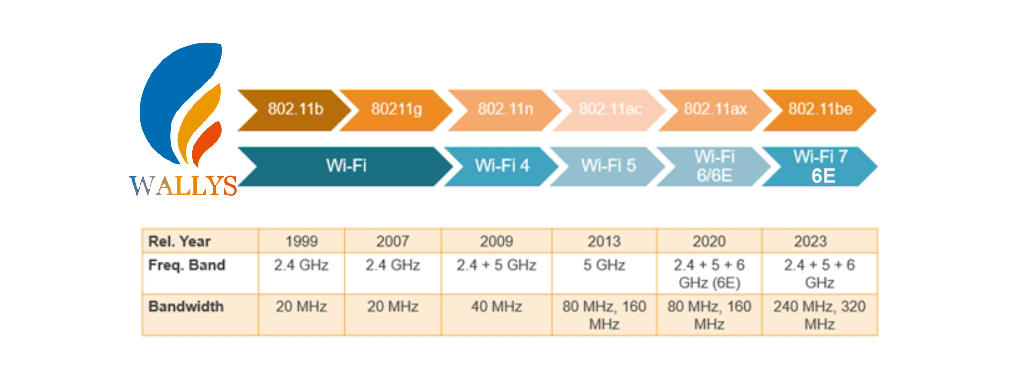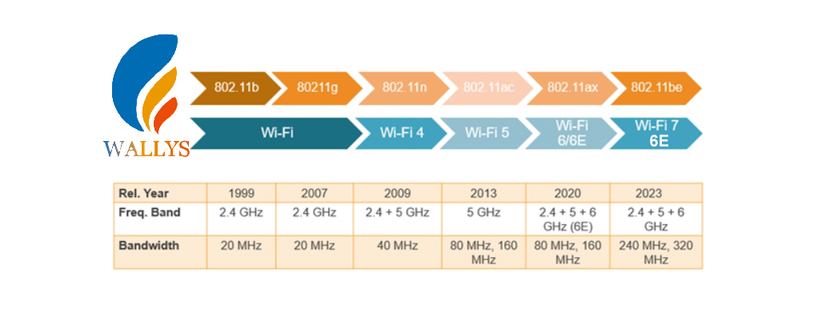Triband QCN9024 work with IPQ6010-IPQ8072 - achieve higher speed bandwidth, more available channels

Triband QCN9024 work with IPQ6010-IPQ8072 - achieve higher speed and bandwidth, more available channels
The advantage of one network card supporting 2.4GHz, 5GHz and 6GHz frequency bands is that it can provide wider frequency band coverage, thereby providing greater flexibility and performance in diverse network environments. Here are the main advantages of this tri-band network card:
Higher speeds and bandwidth: The 6GHz band is part of WiFi 6E, providing higher speeds and greater bandwidth. This means you can achieve faster data transfer speeds on higher frequency bands, enabling more high-bandwidth applications such as 8K video streaming, virtual reality and augmented reality applications.

Mitigating interference: The 6GHz band is relatively new and generally less crowded than the 2.4GHz and 5GHz bands. This means less interference, more reliable connections and lower latency. This is very important for applications that require low-latency connections, such as online gaming and real-time video calls.
More available channels: The 6GHz band provides more available channels, which means more devices can be accommodated in high-density network environments without causing interference or congestion. This is useful for enterprise networks and WiFi in high-density public spaces.
Compatibility and future readiness: Tri-band network cards support the 2.4GHz, 5GHz and 6GHz frequency bands, making them compatible with a variety of WiFi networks. At the same time, it prepares for future network needs, as the 6GHz band is expected to become a more common WiFi standard in the future.
Adapt to different devices: Different devices may perform best on different frequency bands. By having three bands, you can optimize performance by connecting your devices to the band that best suits them based on their needs.
Overall, a tri-band network card that supports the 2.4GHz, 5GHz and 6GHz bands can provide higher speeds, greater bandwidth, more reliable connections, less interference, more channels and better future preparedness performance. This is useful in network environments that require high performance, low latency, and multi-device connectivity, especially with the adoption of next-generation WiFi standards.
Using a network card with three bands (2.4GHz, 5GHz and 6GHz) can still provide some advantages when paired with a motherboard that supports both 2.4GHz and 5GHz bands, even though the motherboard only supports two bands. The following are the main advantages of this configuration:
Band Splitting: Using a network card with three bands, you can connect the motherboard to the 2.4GHz and 5GHz bands while connecting the network card to the 6GHz band (if you have a supported router). This ensures that devices on the motherboard will not interfere with devices on the network card on the same frequency band, improving overall network performance.
Flexibility: With a network card that supports multiple bands, you have the flexibility to choose which devices connect to which band as needed. For example, older devices on the motherboard can be connected to the 2.4GHz band, while devices that require higher speeds can be connected to the 5GHz or 6GHz bands, optimizing performance based on the device's needs.
Future Readiness: Although the motherboard only supports the 2.4GHz and 5GHz frequency bands, using a 6GHz-capable network card will prepare you for future upgrades. If you later upgrade to a router that supports 6GHz, you can continue to use your existing network card without replacing it.
Reduce the load on the motherboard: Using the 6GHz band on the network card can share the load between the 2.4GHz and 5GHz bands on the motherboard. This helps reduce the load on the motherboard and improves the performance of devices on the motherboard, especially in high-density network environments.
It should be noted that devices on the motherboard are still limited by the frequency band supported by the motherboard. Therefore, if the motherboard only supports the 2.4GHz and 5GHz bands, those devices are still limited by those bands and cannot take advantage of the high speed and low interference performance of the 6GHz band. But overall, having a network card that supports multiple bands can provide some flexibility and performance benefits in certain situations, especially in complex network environments.
Vendors supplying products with multi-band products, such as network cards or routers supporting 2.4GHz, 5GHz and 6GHz, can gain a series of advantages that can help gain a competitive advantage in the market:
Technology leadership and innovation: Providing multi-band products shows that the supplier has a leading position in the technology field and is concerned about future network technology trends. This ability to innovate helps attract customers looking for high performance and future readiness.
Market Diversity: Multi-band products can meet customers with various network needs, from home users to enterprise users, from low bandwidth requirements to high bandwidth requirements, from traditional WiFi to new generation WiFi standards. Such market diversity can expand a supplier's customer base.
Competitive advantage: In a highly competitive market, having a multi-band product can differentiate a vendor from its competitors. Customers tend to choose suppliers that offer more choice and flexibility.
Product portfolio completeness: Multi-band products can be included as part of a supplier's product portfolio, adding to the overall product portfolio completeness. This can make the supplier a one-stop shopping destination for customers, thereby increasing customer satisfaction.
Future-ready: Support for the latest WiFi standards and frequency bands shows that the vendor is paying attention to future network trends, which is very attractive to customers who want to invest in future-ready technology.
High-end market appeal: Multi-band products are often used in the high-end market because they offer higher performance and wider coverage. This means suppliers have the opportunity to attract high-value customers and increase profit margins.
Brand Value: Providing high-performance, future-ready products can enhance a supplier’s brand value and reputation. This can attract more customers and partners and promote business growth.
Compliance and Sustainability: Some countries and regions may regulate the use of specific frequency bands, and having multi-band products can help meet compliance requirements in different markets. In addition, supporting new frequency bands also contributes to sustainability as it alleviates congestion issues in the 2.4GHz and 5GHz bands and improves network efficiency.











评论